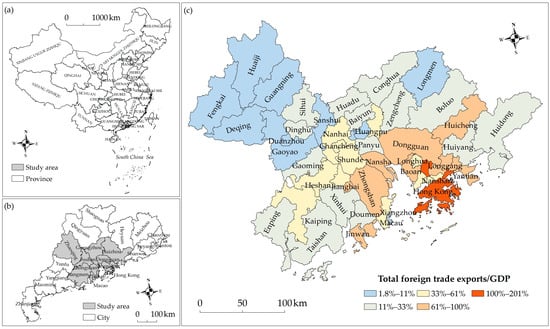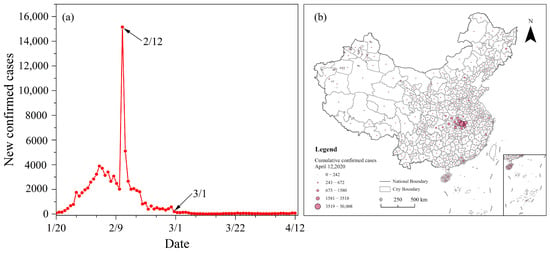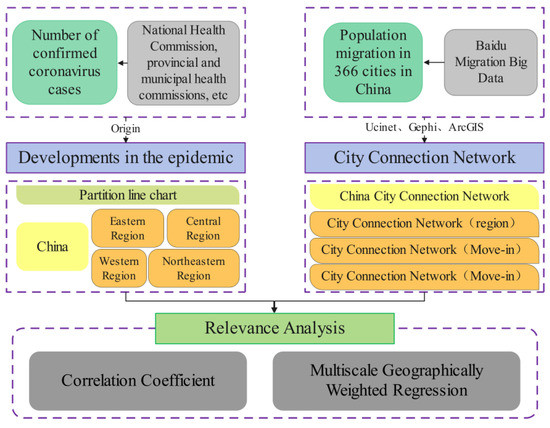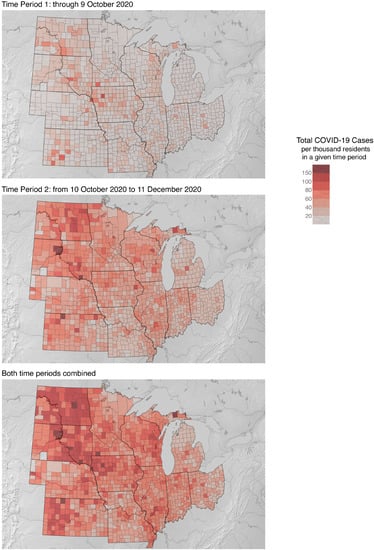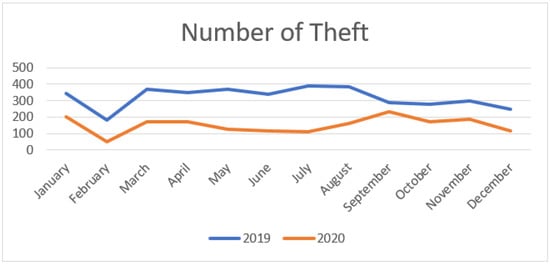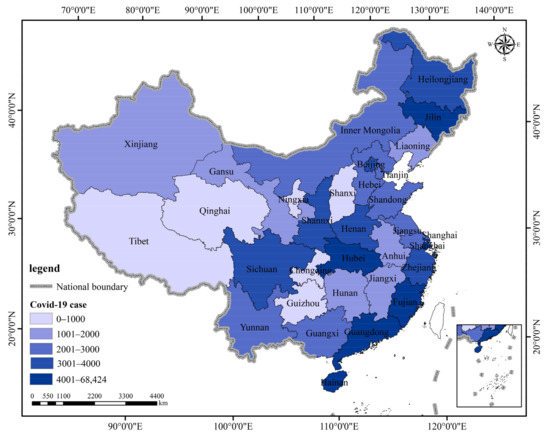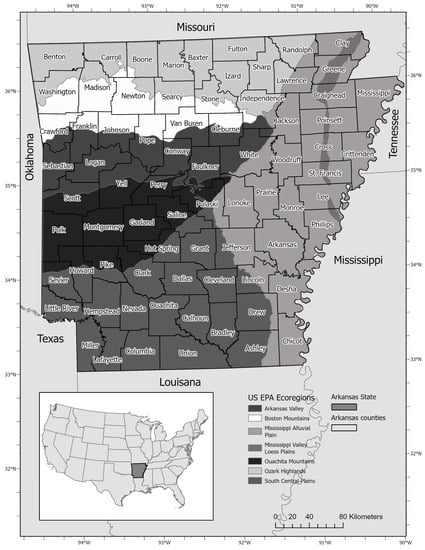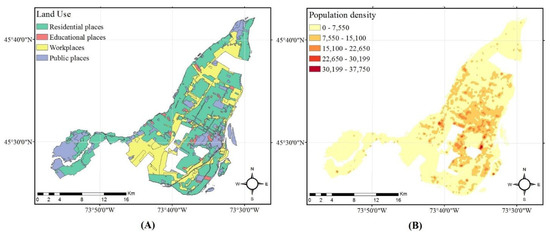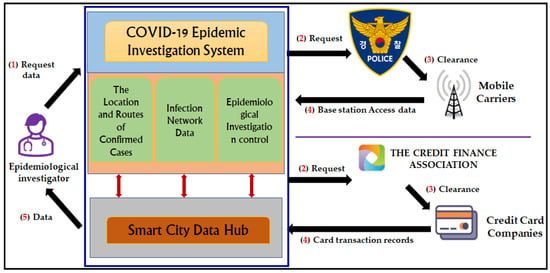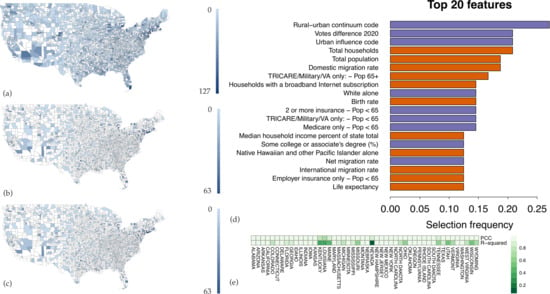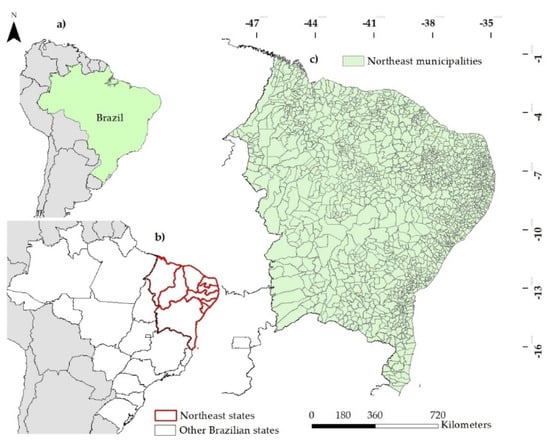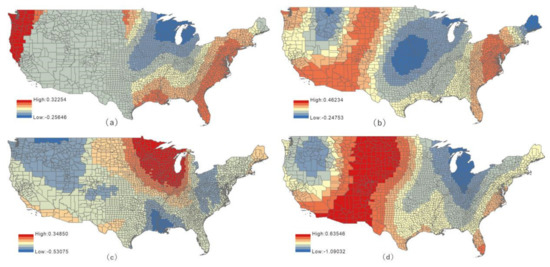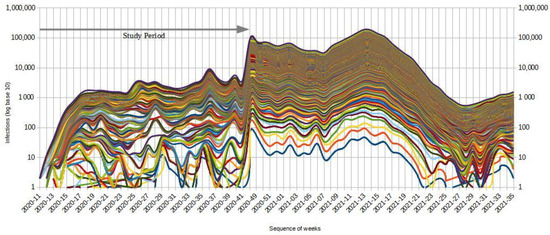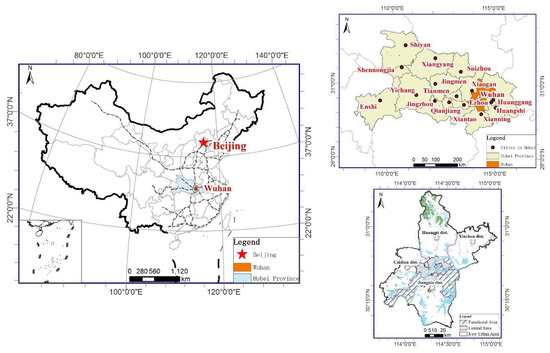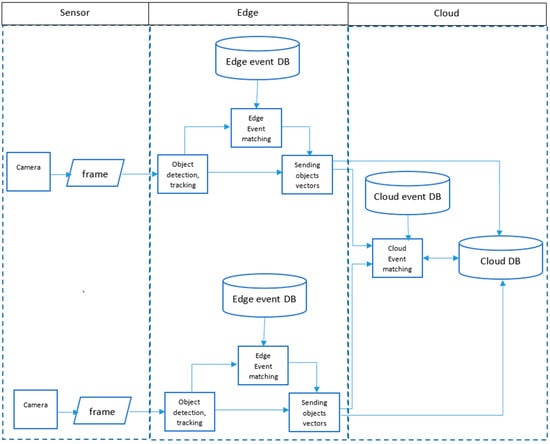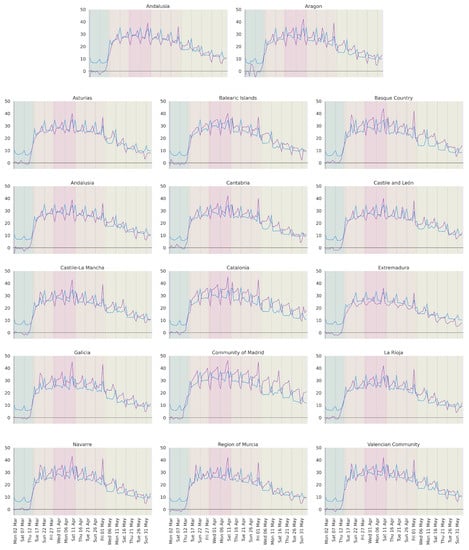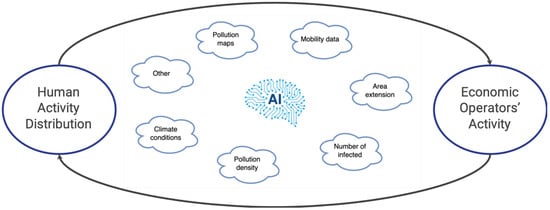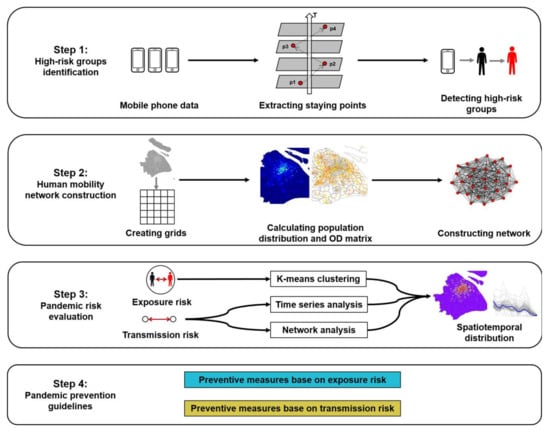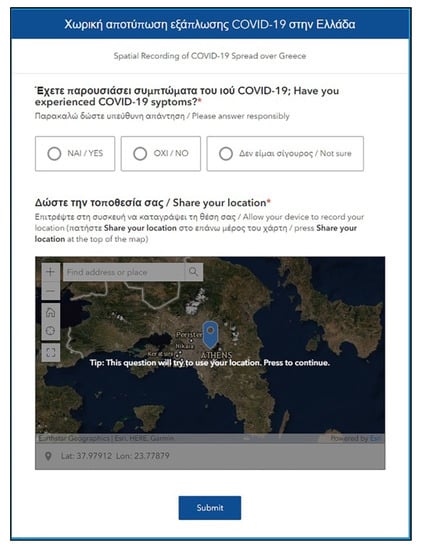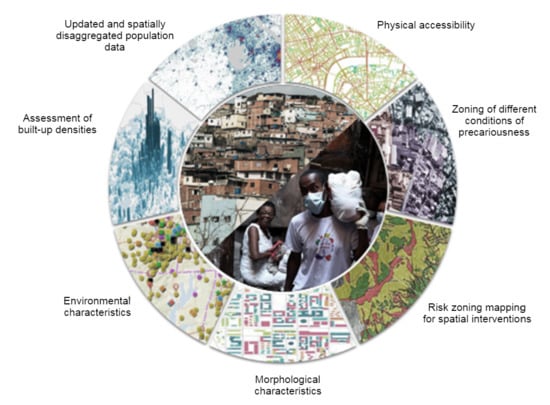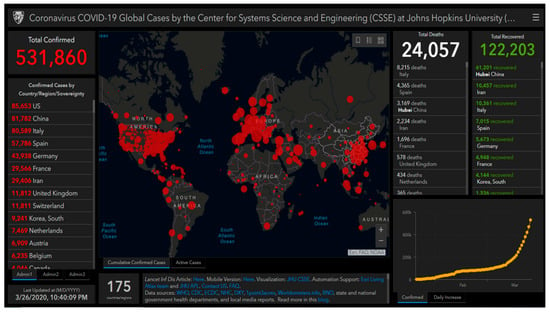Spatial Components of COVID-19 Pandemic
(Closed)
Share This Topical Collection
Editors
 Prof. Dr. Fazlay S. Faruque
Prof. Dr. Fazlay S. Faruque
 Prof. Dr. Fazlay S. Faruque
Prof. Dr. Fazlay S. Faruque
E-Mail
Website
Collection Editor
Department of Preventive Medicine, University of Mississippi Medical Center, 2500 North State Street, Jackson, MS 39216-4505, USA
Interests: geospatial health; environmental health; landscape epidemiology; population health geography; geospatial health disparities; geospatial analysis of eco-social determinants; application of earth observation resources in health studies
Special Issues, Collections and Topics in MDPI journals
 Dr. Mo Ashifur Rahim
Dr. Mo Ashifur Rahim
 Dr. Mo Ashifur Rahim
Dr. Mo Ashifur Rahim
E-Mail
Website
Collection Editor
Sydney Medical Center, 580 George St, Sydney, NSW 2000, Australia
Interests: general clinical practice; preventive medicine; public health; community health; public health education; mental health; nutritional health
Topical Collection Information
Dear Colleagues,
The COVID-19 pandemic is challenging economies and current healthcare systems in countries all over the world. Predicting the spread of SARS-COV-2 and efficient deployment of resources have become critically important. Understanding the spatial components of the disease and the virus can lead to the effective application of spatial technologies in modeling disease transmission and developing projections of cases, hospitalizations, and required resources.
This Special Collection of IJGI is expected to serve as a knowledge exchange platform presenting the latest advances in spatial technological applications to combat this unprecedented situation of COVID-19. This collection hopefully will guide professionals if in the future there is another pandemic of this nature to better prepare saving lives.
We invite authors to submit original scientific papers on the application of spatial technologies for managing COVID-19 including, but not limited to, the following topics:
- Understanding the spatial components of the disease and the virus;
- Spatio-temporal prediction models;
- Healthcare resource requirements during spatio-temporal dynamics;
- Spatial variability in risk factors;
- Spatial tracking;
- Spatial distance vs social distance;
- Global vs local patterns;
- Prevention plan;
- Environmental factors impacting the survival and spread of SARS-COV-2;
- Environmental exposures on vulnerability of COVID-19;
- Impact of COVID-19 lockdown on environment.
Prof. Dr. Fazlay S. Faruque
Prof. Dr. Peng Jia
Dr. Mo Ashifur Rahim
Collection Editors
Manuscript Submission Information
Manuscripts should be submitted online at www.mdpi.com by registering and logging in to this website. Once you are registered, click here to go to the submission form. Manuscripts can be submitted until the deadline. All submissions that pass pre-check are peer-reviewed. Accepted papers will be published continuously in the journal (as soon as accepted) and will be listed together on the collection website. Research articles, review articles as well as short communications are invited. For planned papers, a title and short abstract (about 100 words) can be sent to the Editorial Office for announcement on this website.
Submitted manuscripts should not have been published previously, nor be under consideration for publication elsewhere (except conference proceedings papers). All manuscripts are thoroughly refereed through a single-blind peer-review process. A guide for authors and other relevant information for submission of manuscripts is available on the Instructions for Authors page. ISPRS International Journal of Geo-Information is an international peer-reviewed open access monthly journal published by MDPI.
Please visit the Instructions for Authors page before submitting a manuscript.
The Article Processing Charge (APC) for publication in this open access journal is 1700 CHF (Swiss Francs).
Submitted papers should be well formatted and use good English. Authors may use MDPI's
English editing service prior to publication or during author revisions.
Published Papers (22 papers)
Open AccessArticle
Research on the Evolution and Driving Factors of the Economic Spatial Pattern of the Guangdong–Hong Kong–Macao Greater Bay Area in the Context of the COVID-19 Epidemic
by
Xiaojin Huang, Renzhong Guo, Xiaoming Li, Minmin Li, Yong Fan and Yaxing Li
Viewed by 1890
Abstract
Understanding the economic impact of COVID-19 is the foundation for formulating targeted policies promoting economic recovery. This study uses panel data of the county economy in the Guangdong–Hong Kong–Macao Greater Bay Area (GBA) from 2017 to 2022. Firstly, the evolution characteristics of the
[...] Read more.
Understanding the economic impact of COVID-19 is the foundation for formulating targeted policies promoting economic recovery. This study uses panel data of the county economy in the Guangdong–Hong Kong–Macao Greater Bay Area (GBA) from 2017 to 2022. Firstly, the evolution characteristics of the economic structure in the GBA were analyzed using the standard deviation ellipse, geographical concentration, and spatial autocorrelation methods. Then, we revealed the changes in various economic indicators. Finally, a spatial Durbin model was constructed to study the factors affecting economic growth and spatial spillover effects in different periods. The results reveal that the economic distribution in the GBA presents a “core–edge” structure. The FDI, consumption, and exports of the Greater Bay Area fluctuate greatly, while investment growth is relatively stable. There is a significant spatial spillover effect in the county economy of the GBA. Investment, consumption, exports, labor, and innovation all have significant positive effects on economic growth, with investment having the greatest impact, while FDI has a significant negative impact. The impact of COVID-19 on the economy of the GBA is mainly reflected in the weakening of spatial spillovers, the strengthening of economic agglomeration, the decline in factor growth, and the change in the driving effect of factors on the economy. These findings can provide a reference for formulating targeted economic development policies.
Full article
►▼
Show Figures
Open AccessArticle
A Head/Tail Breaks-Based Approach to Characterizing Space-Time Risks of COVID-19 Epidemic in China’s Cities
by
Tingting Wu, Bisong Hu, Jin Luo and Shuhua Qi
Viewed by 2067
Abstract
The novel coronavirus pneumonia (COVID-19) pandemic has caused enormous impacts around the world. Characterizing the risk dynamics for urgent epidemics such as COVID-19 is of great benefit to epidemic control and emergency management. This article presents a novel approach to characterizing the space-time
[...] Read more.
The novel coronavirus pneumonia (COVID-19) pandemic has caused enormous impacts around the world. Characterizing the risk dynamics for urgent epidemics such as COVID-19 is of great benefit to epidemic control and emergency management. This article presents a novel approach to characterizing the space-time risks of the COVID-19 epidemic. We analyzed the heavy-tailed distribution and spatial hierarchy of confirmed COVID-19 cases in 367 cities from 20 January to 12 April 2020, and population density data for 2019, and modelled two parameters, COVID-19 confirmed cases and population density, to measure the risk value of each city and assess the epidemic from the perspective of spatial and temporal changes. The evolution pattern of high-risk areas was assessed from a spatial and temporal perspective. The number of high-risk cities decreased from 57 in week 1 to 6 in week 12. The results show that the risk measurement model based on the head/tail breaks approach can describe the spatial and temporal evolution characteristics of the risk of COVID-19, and can better predict the risk trend of future epidemics in each city and identify the risk of future epidemics even during low incidence periods. Compared with the traditional risk assessment method model, it pays more attention to the differences in the spatial level of each city and provides a new perspective for the assessment of the risk level of epidemic transmission. It has generality and flexibility and provides a certain reference for the prevention of infectious diseases as well as a theoretical basis for government implementation strategies.
Full article
►▼
Show Figures
Open AccessArticle
A Study of the Impact of COVID-19 on Urban Contact Networks in China Based on Population Flows
by
Xuejie Zhang, Jinli Zhao, Haimeng Liu, Yi Miao, Mengcheng Li and Chengxin Wang
Cited by 1 | Viewed by 3458
Abstract
The emergence and enduring diffusion of COVID-19 has had a dramatic impact on cities worldwide. The scientific aim of this study was to introduce geospatial thinking to research related to infectious diseases, while the practical aim was to explore the impact on population
[...] Read more.
The emergence and enduring diffusion of COVID-19 has had a dramatic impact on cities worldwide. The scientific aim of this study was to introduce geospatial thinking to research related to infectious diseases, while the practical aim was to explore the impact on population movements and urban linkages in the longer term following a pandemic outbreak. Therefore, this study took 366 cities in China as the research subjects while exploring the relationship between urban contact and the outbreak of the pandemic from both national and regional perspectives using social network analysis (SNA), Pearson correlation analysis and multi-scale geographically weighted regression (MGWR) modeling. The results revealed that the number of COVID-19 infections in China fluctuated with strain variation over the study period; the urban contact network exhibited a significant trend of recovery. The pandemic had a hindering effect on national urban contact, and this effect weakened progressively. Meanwhile, the effect exhibited significant spatial heterogeneity, with a weakening effect in the eastern region ≈ northeast region > central region > western region, indicating a decreasing phenomenon from coastal to inland areas. Moreover, the four major economic regions in China featured border barrier effects, whereby urban contact networks constituted by cross-regional flows were more sensitive to the development of the pandemic. The geostatistical approach adopted in this study related to infectious disease and urban linkages can be used in other regions, and its findings provide a reference for China and other countries around the world to respond to major public health events.
Full article
►▼
Show Figures
Open AccessEditor’s ChoiceArticle
Dominant Modes of Agricultural Production Helped Structure Initial COVID-19 Spread in the U.S. Midwest
by
Luke Bergmann, Luis Fernando Chaves, David O’Sullivan and Robert G. Wallace
Cited by 4 | Viewed by 4284
Abstract
The spread of COVID-19 is geographically uneven in agricultural regions. Explanations proposed include differences in occupational risks, access to healthcare, racial inequalities, and approaches to public health. Here, we additionally explore the impacts of coexisting modes of agricultural production across counties from twelve
[...] Read more.
The spread of COVID-19 is geographically uneven in agricultural regions. Explanations proposed include differences in occupational risks, access to healthcare, racial inequalities, and approaches to public health. Here, we additionally explore the impacts of coexisting modes of agricultural production across counties from twelve midwestern U.S. states. In modeling COVID-19 spread before vaccine authorization, we employed and extended spatial statistical methods that make different assumptions about the natures and scales of underlying sociospatial processes. In the process, we also develop a novel approach to visualizing the results of geographically weighted regressions that allows us to identify distinctive regional regimes of epidemiological processes. Our approaches allowed for models using abstract spatial weights (e.g., inverse-squared distances) to be meaningfully improved by also integrating process-specific relations (e.g., the geographical relations of the food system or of commuting). We thus contribute in several ways to methods in health geography and epidemiology for identifying contextually sensitive public engagements in socio-eco-epidemiological issues. Our results further show that agricultural modes of production are associated with the spread of COVID-19, with counties more engaged in modes of regenerative agricultural production having lower COVID-19 rates than those dominated by modes of conventional agricultural production, even when accounting for other factors.
Full article
►▼
Show Figures
Open AccessArticle
Spatiotemporal Distribution and Influencing Factors of Theft during the Pre-COVID-19 and COVID-19 Periods: A Case Study of Haining City, Zhejiang, China
by
Xiaomin Jiang, Ziwan Zheng, Ye Zheng and Zhewei Mao
Cited by 2 | Viewed by 2605
Abstract
Theft is an inevitable problem in the context of urbanization and poses a challenge to people’s lives and social stability. The study of theft and criminal behavior using spatiotemporal, big, demographic, and neighborhood data is important for guiding security prevention and control. In
[...] Read more.
Theft is an inevitable problem in the context of urbanization and poses a challenge to people’s lives and social stability. The study of theft and criminal behavior using spatiotemporal, big, demographic, and neighborhood data is important for guiding security prevention and control. In this study, we analyzed the theft frequency and location characteristics of the study area through mathematical statistics and hot spot analysis methods to discover the spatiotemporal divergence characteristics of theft in the study area during the pre-COVID-19 and COVID-19 periods. We detected the spatial variation pattern of the regression coefficients of the local areas of thefts in Haining City by modeling the influencing factors using the geographically weighted regression (GWR) analysis method. The results explained the relationship between theft and the influencing factors and showed that the regression coefficients had both positive and negative values in the pre-COVID-19 and COVID-19 periods, indicating that the spatial distribution of theft in urban areas of Haining City was not smooth. Factors related to life and work indicated densely populated areas had increased theft, and theft was negatively correlated with factors related to COVID-19. The other influencing factors were different in terms of their spatial distributions. Therefore, in terms of police prevention and control, video surveillance and police patrols need to be deployed in a focused manner to increase their inhibiting effect on theft according to the different effects of influencing factors during the pre-COVID-19 and COVID-19 periods.
Full article
►▼
Show Figures
Open AccessArticle
Driving Factors and Scale Effects of Residents’ Willingness to Pay for Environmental Protection under the Impact of COVID-19
by
Hongkun Zhao, Yaofeng Yang, Yajuan Chen, Huyang Yu, Zhuo Chen and Zhenwei Yang
Cited by 1 | Viewed by 1862
Abstract
In recent years, environmental degradation and the COVID-19 pandemic have seriously affected economic development and social stability. Addressing the impact of major public health events on residents’ willingness to pay for environmental protection (WTPEP) and analyzing the drivers are necessary for improving human
[...] Read more.
In recent years, environmental degradation and the COVID-19 pandemic have seriously affected economic development and social stability. Addressing the impact of major public health events on residents’ willingness to pay for environmental protection (WTPEP) and analyzing the drivers are necessary for improving human well-being and environmental sustainability. We designed a questionnaire to analyze the change in residents’ WTPEP before and during COVID-19 and an established ordinary least squares (OLS), spatial lag model (SLM), spatial error model (SEM), geographically weighted regression (GWR), and multiscale GWR to explore driver factors and scale effects of WTPEP based on the theory of environment Kuznets curve (EKC). The results show that (1) WTPEP is 0–20,000 yuan before COVID-19 and 0–50,000 yuan during COVID-19. Residents’ WTPEP improved during COVID-19, which indicates that residents’ demand for an ecological environment is increasing; (2) The shapes and inflection points of the relationships between income and WTPEP are spatially heterogeneous before and during COVID-19, but the northern WTPEP is larger than southern, which indicates that there is a spatial imbalance in WTPEP; (3) Environmental degradation, health, environmental quality, and education are WTPEP’s significant macro-drivers, whereas income, age, and gender are significant micro-drivers. Those factors can help policymakers better understand which factors are more suitable for macro or micro environmental policy-making and what targeted measures could be taken to solve the contradiction between the growing ecological environment demand of residents and the spatial imbalance of WTPEP in the future.
Full article
►▼
Show Figures
Open AccessArticle
Geospatial Modeling of Health, Socioeconomic, Demographic, and Environmental Factors with COVID-19 Incidence Rate in Arkansas, US
by
Yaqian He, Paul J. Seminara, Xiao Huang, Di Yang, Fang Fang and Chao Song
Cited by 6 | Viewed by 3674
Abstract
The COVID-19 pandemic has posed numerous challenges to human society. Previous studies explored multiple factors in virus transmission. Yet, their impacts on COVID-19 are not universal and vary across geographical regions. In this study, we thoroughly quantified the spatiotemporal associations of 49 health,
[...] Read more.
The COVID-19 pandemic has posed numerous challenges to human society. Previous studies explored multiple factors in virus transmission. Yet, their impacts on COVID-19 are not universal and vary across geographical regions. In this study, we thoroughly quantified the spatiotemporal associations of 49 health, socioeconomic, demographic, and environmental factors with COVID-19 at the county level in Arkansas, US. To identify the associations, we applied the ordinary least squares (OLS) linear regression, spatial lag model (SLM), spatial error model (SEM), and multiscale geographically weighted regression (MGWR) model. To reveal how such associations change across different COVID-19 times, we conducted the analyses for each season (i.e., spring, summer, fall, and winter) from 2020 to 2021. We demonstrate that there are different driving factors along with different COVID-19 variants, and their magnitudes change spatiotemporally. However, our results identify that adult obesity has a positive association with the COVID-19 incidence rate over entire Arkansas, thus confirming that people with obesity are vulnerable to COVID-19. Humidity consistently negatively affects COVID-19 across all seasons, denoting that increasing humidity could reduce the risk of COVID-19 infection. In addition, diabetes shows roles in the spread of both early COVID-19 variants and Delta, while humidity plays roles in the spread of Delta and Omicron. Our study highlights the complexity of how multifactor affect COVID-19 in different seasons and counties in Arkansas. These findings are useful for informing local health planning (e.g., vaccine rollout, mask regulation, and testing/tracing) for the residents in Arkansas.
Full article
►▼
Show Figures
Open AccessFeature PaperArticle
Geocomputational Approach to Simulate and Understand the Spatial Dynamics of COVID-19 Spread in the City of Montreal, QC, Canada
by
Navid Mahdizadeh Gharakhanlou and Liliana Perez
Cited by 3 | Viewed by 2405
Abstract
Throughout history, pandemics have forced societies to think beyond typical management and control protocols. The main goals of this study were to simulate and understand the spatial dynamics of COVID-19 spread and assess the efficacy of two policy measures in Montreal, Canada, to
[...] Read more.
Throughout history, pandemics have forced societies to think beyond typical management and control protocols. The main goals of this study were to simulate and understand the spatial dynamics of COVID-19 spread and assess the efficacy of two policy measures in Montreal, Canada, to mitigate the COVID-19 outbreak. We simulated the COVID-19 outbreak using a Geographical Information System (GIS)-based agent-based model (ABM) and two management scenarios as follows: (1) human mobility reduction; and (2) observation of self-isolation. The ABM description followed the ODD (Overview, Design concepts, Details) protocol. Our simulation experiments indicated that the mainstream of COVID-19 transmissions (i.e., approximately 90.34%) occurred in public places. Besides, the results indicated that the rules aiming to reduce population mobility, led to a reduction of about 63 infected people each week, on average. Furthermore, our scenarios revealed that if instead of 42% (i.e., the adjusted value in the calibration), 10%, 20%, and 30% of infectious people had followed the self-isolation measure, the number of infected people would have risen by approximately 259, 207, and 83 more each week, on average, respectively. The map of critical locations of COVID-19 spreading resulted from our modeling and the evaluated effectiveness of two control measures on the COVID-19 outbreak could assist health policymakers to navigate through the pandemic.
Full article
►▼
Show Figures
Open AccessFeature PaperTechnical Note
Technical Analysis of Contact Tracing Platform Developed by Google–Apple for Constraining the Spread of COVID-19
by
Abdul Majeed
Cited by 3 | Viewed by 2762
Abstract
Amid the ongoing COVID-19 pandemic, technical solutions (e.g., smartphone apps, web-based platforms, digital surveillance platforms, etc.) have played a vital role in constraining the spread of COVID-19. The major aspects in which technical solutions have helped the general public (or health officials) are
[...] Read more.
Amid the ongoing COVID-19 pandemic, technical solutions (e.g., smartphone apps, web-based platforms, digital surveillance platforms, etc.) have played a vital role in constraining the spread of COVID-19. The major aspects in which technical solutions have helped the general public (or health officials) are contact tracing, spread prediction, trend forecasting, infection risk estimation, hotspot identification, alerting people to stay away from contaminated places, hospitalization length estimation, clinical severity analysis, and quarantine monitoring, to name a few. Apart from other services, contact tracing has been extensively performed with the help of Bluetooth and GPS-powered smartphone applications when vaccines were unavailable. In this article, we technically analyze the contact tracing platform developed by Google–Apple for constraining the spread of COVID-19. We suggest unexplored technical functionalities that can further strengthen the platform from privacy preservation, service scenarios, and robustness point of view. Lastly, some AI-based and privacy-assured services that can be integrated with the platform to control the pandemic adequately are suggested. The technical analysis demonstrates that while the Google–Apple platform is well-engineered, it is not free of vulnerabilities, weaknesses, and misconfigurations that may lead to its poor adoption in real-life scenarios. This work can serve as a guideline for further enhancing the practicality of contact tracing platform to effectively handle future infectious diseases.
Full article
►▼
Show Figures
Open AccessArticle
Spatial Prediction of COVID-19 Pandemic Dynamics in the United States
by
Çiğdem Ak, Alex D. Chitsazan, Mehmet Gönen, Ruth Etzioni and Aaron J. Grossberg
Cited by 2 | Viewed by 2317
Abstract
The impact of COVID-19 across the United States (US) has been heterogeneous, with rapid spread and greater mortality in some areas compared with others. We used geographically-linked data to test the hypothesis that the risk for COVID-19 was defined by location and sought
[...] Read more.
The impact of COVID-19 across the United States (US) has been heterogeneous, with rapid spread and greater mortality in some areas compared with others. We used geographically-linked data to test the hypothesis that the risk for COVID-19 was defined by location and sought to define which demographic features were most closely associated with elevated COVID-19 spread and mortality. We leveraged geographically-restricted social, economic, political, and demographic information from US counties to develop a computational framework using structured Gaussian process to predict county-level case and death counts during the pandemic’s initial and nationwide phases. After identifying the most predictive information sources by location, we applied an unsupervised clustering algorithm and topic modeling to identify groups of features most closely associated with COVID-19 spread. Our model successfully predicted COVID-19 case counts of unseen locations after examining case counts and demographic information of neighboring locations, with overall Pearson’s correlation coefficient and the proportion of variance explained as 0.96 and 0.84 during the initial phase and 0.95 and 0.87 during the nationwide phase, respectively. Aside from population metrics, presidential vote margin was the most consistently selected spatial feature in our COVID-19 prediction models. Urbanicity and 2020 presidential vote margins were more predictive than other demographic features. Models trained using death counts showed similar performance metrics. Topic modeling showed that counties with similar socioeconomic and demographic features tended to group together, and some of these feature sets were associated with COVID-19 dynamics. Clustering of counties based on these feature groups found by topic modeling revealed groups of counties that experienced markedly different COVID-19 spread. We conclude that topic modeling can be used to group similar features and identify counties with similar features in epidemiologic research.
Full article
►▼
Show Figures
Open AccessArticle
Measuring COVID-19 Vulnerability for Northeast Brazilian Municipalities: Social, Economic, and Demographic Factors Based on Multiple Criteria and Spatial Analysis
by
Ciro José Jardim de Figueiredo, Caroline Maria de Miranda Mota, Kaliane Gabriele Dias de Araújo, Amanda Gadelha Ferreira Rosa and Arthur Pimentel Gomes de Souza
Cited by 6 | Viewed by 2156
Abstract
COVID-19 has brought several harmful consequences to the world from many perspectives, including social, economic, and well-being in addition to health issues. However, these harmful consequences vary in intensity in different regions. Identifying which cities are most vulnerable to COVID-19 and understanding which
[...] Read more.
COVID-19 has brought several harmful consequences to the world from many perspectives, including social, economic, and well-being in addition to health issues. However, these harmful consequences vary in intensity in different regions. Identifying which cities are most vulnerable to COVID-19 and understanding which variables could be associated with the advance of registered cases is a challenge. Therefore, this study explores and builds a spatial decision model to identify the characteristics of the cities that are most vulnerable to COVID-19, taking into account social, economic, demographic, and territorial aspects. Hence, 18 features were separated into the four groups mentioned. We employed a model joining the dominance-based rough set approach to aggregate the features (multiple criteria) and spatial analysis (Moran index, and Getis and Ord) to obtain final results. The results show that the most vulnerable places have characteristics with high population density and poor economic conditions. In addition, we conducted subsequent analysis to validate the results. The case was developed in the northeast region of Brazil.
Full article
►▼
Show Figures
Open AccessArticle
Moderating Effect of a Cross-Level Social Distancing Policy on the Disparity of COVID-19 Transmission in the United States
by
Zhenwei Luo, Lin Li, Jianfang Ma, Zhuo Tang, Hang Shen, Haihong Zhu and Bin Wu
Cited by 4 | Viewed by 2878
Abstract
Currently, coronavirus disease 2019 (COVID-19) remains a global pandemic, but the prevention and control of the disease in various countries have also entered the normalization stage. To achieve economic recovery and avoid a waste of resources, different regions have developed prevention and control
[...] Read more.
Currently, coronavirus disease 2019 (COVID-19) remains a global pandemic, but the prevention and control of the disease in various countries have also entered the normalization stage. To achieve economic recovery and avoid a waste of resources, different regions have developed prevention and control strategies according to their social, economic, and medical conditions and culture. COVID-19 disparities under the interaction of various factors, including interventions, need to be analyzed in advance for effective and precise prevention and control. Considering the United States as the study case, we investigated statistical and spatial disparities based on the impact of the county-level social vulnerability index (SVI) on the COVID-19 infection rate. The county-level COVID-19 infection rate showed very significant heterogeneity between states, where 67% of county-level disparities in COVID-19 infection rates come from differences between states. A hierarchical linear model (HLM) was adopted to examine the moderating effects of state-level social distancing policies on the influence of the county-level SVI on COVID-19 infection rates, considering the variation in data at a unified level and the interaction of various data at different levels. Although previous studies have shown that various social distancing policies inhibit COVID-19 transmission to varying degrees, this study explored the reasons for the disparities in COVID-19 transmission under various policies. For example, we revealed that the state-level restrictions on the internal movement policy significantly attenuate the positive effect of county-level economic vulnerability indicators on COVID-19 infection rates, indirectly inhibiting COVID-19 transmission. We also found that not all regions are suitable for the strictest social distancing policies. We considered the moderating effect of multilevel covariates on the results, allowing us to identify the causes of significant group differences across regions and to tailor measures of varying intensity more easily. This study is also necessary to accomplish targeted preventative measures and to allocate resources.
Full article
►▼
Show Figures
Open AccessArticle
Modeling the Spatial and Temporal Spread of COVID-19 in Poland Based on a Spatial Interaction Model
by
Piotr A. Werner, Małgorzata Kęsik-Brodacka, Karolina Nowak, Robert Olszewski, Mariusz Kaleta and David T. Liebers
Cited by 12 | Viewed by 3824
Abstract
This article describes an original methodology for integrating global SIR-like epidemic models with spatial interaction models, which enables the forecasting of COVID-19 dynamics in Poland through time and space. Mobility level, estimated by the regional population density and distances among inhabitants, was the
[...] Read more.
This article describes an original methodology for integrating global SIR-like epidemic models with spatial interaction models, which enables the forecasting of COVID-19 dynamics in Poland through time and space. Mobility level, estimated by the regional population density and distances among inhabitants, was the determining variable in the spatial interaction model. The spatiotemporal diffusion model, which allows the temporal prediction of case counts and the possibility of determining their spatial distribution, made it possible to forecast the dynamics of the COVID-19 pandemic at a regional level in Poland. This model was used to predict incidence in 380 counties in Poland, which represents a much more detailed modeling than NUTS 3 according to the widely used geocoding standard Nomenclature of Territorial Units for Statistics. The research covered the entire territory of Poland in seven weeks of early 2021, just before the start of vaccination in Poland. The results were verified using official epidemiological data collected by sanitary and epidemiological stations. As the conducted analyses show, the application of the approach proposed in the article, integrating epidemiological models with spatial interaction models, especially unconstrained gravity models and destination (attraction) constrained models, leads to obtaining almost 90% of the coefficient of determination, which reflects the quality of the model’s fit with the spatiotemporal distribution of the validation data.
Full article
►▼
Show Figures
Open AccessArticle
Population Mobility and the Transmission Risk of the COVID-19 in Wuhan, China
by
Minghai Luo, Sixian Qin, Bo Tan, Mingming Cai, Yufeng Yue and Qiangqiang Xiong
Cited by 13 | Viewed by 4059
Abstract
At the beginning of 2020, a suddenly appearing novel coronavirus (COVID-19) rapidly spread around the world. The outbreak of the COVID-19 pandemic in China occurred during the Spring Festival when a large number of migrants traveled between cities, which greatly increased the infection
[...] Read more.
At the beginning of 2020, a suddenly appearing novel coronavirus (COVID-19) rapidly spread around the world. The outbreak of the COVID-19 pandemic in China occurred during the Spring Festival when a large number of migrants traveled between cities, which greatly increased the infection risk of COVID-19 across the country. Financially supported by the Wuhan government, and based on cellphone signaling data from Unicom (a mobile phone carrier) and Baidu location-based data, this paper analyzed the effects that city dwellers, non-commuters, commuters, and people seeking medical services had on the transmission risk of COVID-19 in the early days of the pandemic in Wuhan. The paper also evaluated the effects of the city lockdown policy on the spread of the pandemic outside and inside Wuhan. The results show that although the daily business activities in the South China Seafood Wholesale Market and nearby commuters’ travel behaviors concentrated in the Hankou area, a certain proportion of these people were distributed in the Wuchang and Hanyang areas. The areas with relatively high infection risks of COVID-19 were scattered across Wuhan during the early outbreak of the pandemic. The lockdown in Wuhan closed the passageways of external transport at the very beginning, largely decreasing migrant population and effectively preventing the spread of the pandemic to the outside. However, the Wuhan lockdown had little effect on preventing the spread of the pandemic within Wuhan at that time. During this period, a large amount of patients who went to hospitals for medical services were exposed to a high risk of cross-infection without precaution awareness. The pandemic kept dispersing in three towns until the improvement of the capacity of medical treatment, the management of closed communities, the national support to Wuhan, and the implementation of a series of emergency responses at the same time. The findings in this paper reveal the spatiotemporal features of the dispersal of infection risk of COVID-19 and the effects of the prevention and control measures during the early days of the pandemic. The findings were adopted by the Wuhan government to make corresponding policies and could also provide supports to the control of the pandemic in the other regions and countries.
Full article
►▼
Show Figures
Open AccessEditor’s ChoiceArticle
Evaluating Social Distancing Measures and Their Association with the Covid-19 Pandemic in South America
by
Gisliany Lillian Alves de Oliveira, Luciana Lima, Ivanovitch Silva, Marcel da Câmara Ribeiro-Dantas, Kayo Henrique Monteiro and Patricia Takako Endo
Cited by 17 | Viewed by 5505
Abstract
Social distancing is a powerful non-pharmaceutical intervention used as a way to slow the spread of the SARS-CoV-2 virus around the world since the end of 2019 in China. Taking that into account, this work aimed to identify variations on population mobility in
[...] Read more.
Social distancing is a powerful non-pharmaceutical intervention used as a way to slow the spread of the SARS-CoV-2 virus around the world since the end of 2019 in China. Taking that into account, this work aimed to identify variations on population mobility in South America during the pandemic (15 February to 27 October 2020). We used a data-driven approach to create a community mobility index from the Google Covid-19 Community Mobility and relate it to the Covid stringency index from Oxford Covid-19 Government Response Tracker (OxCGRT). Two hypotheses were established: countries which have adopted stricter social distancing measures have also a lower level of circulation (H1), and mobility is occurring randomly in space (H2). Considering a transient period, a low capacity of governments to respond to the pandemic with more stringent measures of social distancing was observed at the beginning of the crisis. In turn, considering a steady-state period, the results showed an inverse relationship between the Covid stringency index and the community mobility index for at least three countries (H1 rejected). Regarding the spatial analysis, global and local Moran indices revealed regional mobility patterns for Argentina, Brazil, and Chile (H1 rejected). In Brazil, the absence of coordinated policies between the federal government and states regarding social distancing may have played an important role for several and extensive clusters formation. On the other hand, the results for Argentina and Chile could be signals for the difficulties of governments in keeping their population under control, and for long periods, even under stricter decrees.
Full article
►▼
Show Figures
Open AccessArticle
Design and Development of an Internet of Smart Cameras Solution for Complex Event Detection in COVID-19 Risk Behaviour Recognition
by
Sepehr Honarparvar, Sara Saeedi, Steve Liang and Jeremy Squires
Cited by 4 | Viewed by 3719
Abstract
Emerging deep learning (DL) approaches with edge computing have enabled the automation of rich information extraction, such as complex events from camera feeds. Due to the low speed and accuracy of object detection, some objects are missed and not detected. As objects constitute
[...] Read more.
Emerging deep learning (DL) approaches with edge computing have enabled the automation of rich information extraction, such as complex events from camera feeds. Due to the low speed and accuracy of object detection, some objects are missed and not detected. As objects constitute simple events, missing objects result in missing simple events, thus the number of detected complex events. As the main objective of this paper, an integrated cloud and edge computing architecture was designed and developed to reduce missing simple events. To achieve this goal, we deployed multiple smart cameras (i.e., cameras which connect to the Internet and are integrated with computerised systems such as the DL unit) in order to detect complex events from multiple views. Having more simple events from multiple cameras can reduce missing simple events and increase the number of detected complex events. To evaluate the accuracy of complex event detection, the F-score of risk behaviour regarding COVID-19 spread events in video streams was used. The experimental results demonstrate that this architecture delivered 1.73 times higher accuracy in event detection than that delivered by an edge-based architecture that uses one camera. The average event detection latency for the integrated cloud and edge architecture was 1.85 times higher than that of only one camera. However, this finding was insignificant with regard to the current case study. Moreover, the accuracy of the architecture for complex event matching with more spatial and temporal relationships showed significant improvement in comparison to the edge computing scenario. Finally, complex event detection accuracy considerably depended on object detection accuracy. Regression-based models, such as you only look once (YOLO), were able to provide better accuracy than region-based models.
Full article
►▼
Show Figures
Open AccessArticle
Comparative Analysis of Geolocation Information through Mobile-Devices under Different COVID-19 Mobility Restriction Patterns in Spain
by
Raquel Pérez-Arnal, David Conesa, Sergio Alvarez-Napagao, Toyotaro Suzumura, Martí Català, Enrique Alvarez-Lacalle and Dario Garcia-Gasulla
Cited by 21 | Viewed by 5003
Abstract
The COVID-19 pandemic is changing the world in unprecedented and unpredictable ways. Human mobility, being the greatest facilitator for the spread of the virus, is at the epicenter of this change. In order to study mobility under COVID-19, to evaluate the efficiency of
[...] Read more.
The COVID-19 pandemic is changing the world in unprecedented and unpredictable ways. Human mobility, being the greatest facilitator for the spread of the virus, is at the epicenter of this change. In order to study mobility under COVID-19, to evaluate the efficiency of mobility restriction policies, and to facilitate a better response to future crisis, we need to understand all possible mobility data sources at our disposal. Our work studies private mobility sources, gathered from mobile-phones and released by large technological companies. These data are of special interest because, unlike most public sources, it is focused on individuals rather than on transportation means. Furthermore, the sample of society they cover is large and representative. On the other hand, these data are not directly accessible for anonymity reasons. Thus, properly interpreting its patterns demands caution. Aware of that, we explore the behavior and inter-relations of private sources of mobility data in the context of Spain. This country represents a good experimental setting due to both its large and fast pandemic peak and its implementation of a sustained, generalized lockdown. Our work illustrates how a direct and naive comparison between sources can be misleading, as certain days (e.g., Sundays) exhibit a directly adverse behavior. After understanding their particularities, we find them to be partially correlated and, what is more important, complementary under a proper interpretation. Finally, we confirm that mobile-data can be used to evaluate the efficiency of implemented policies, detect changes in mobility trends, and provide insights into what new normality means in Spain.
Full article
►▼
Show Figures
Open AccessArticle
AIRSENSE-TO-ACT: A Concept Paper for COVID-19 Countermeasures Based on Artificial Intelligence Algorithms and Multi-Source Data Processing
by
Alessandro Sebastianelli, Francesco Mauro, Gianluca Di Cosmo, Fabrizio Passarini, Marco Carminati and Silvia Liberata Ullo
Cited by 9 | Viewed by 8105
Abstract
The aim of this concept paper is the description of a new tool to support institutions in the implementation of targeted countermeasures, based on quantitative and multi-scale elements, for the fight and prevention of emergencies, such as the current COVID-19 pandemic. The tool
[...] Read more.
The aim of this concept paper is the description of a new tool to support institutions in the implementation of targeted countermeasures, based on quantitative and multi-scale elements, for the fight and prevention of emergencies, such as the current COVID-19 pandemic. The tool is a cloud-based centralized system; a multi-user platform that relies on artificial intelligence (AI) algorithms for the processing of heterogeneous data, which can produce as an output the level of risk. The model includes a specific neural network which is first trained to learn the correlations between selected inputs, related to the case of interest: environmental variables (chemical–physical, such as meteorological), human activity (such as traffic and crowding), level of pollution (in particular the concentration of particulate matter) and epidemiological variables related to the evolution of the contagion. The tool realized in the first phase of the project will serve later both as a decision support system (DSS) with predictive capacity, when fed by the actual measured data, and as a simulation bench performing the tuning of certain input values, to identify which of them led to a decrease in the degree of risk. In this way, we aimed to design different scenarios to compare different restrictive strategies and the actual expected benefits, to adopt measures sized to the actual needs, adapted to the specific areas of analysis and useful for safeguarding human health; and we compared the economic and social impacts of the choices. Although ours is a concept paper, some preliminary analyses have been shown, and two different case studies are presented, whose results have highlighted a correlation between NO
, mobility and COVID-19 data. However, given the complexity of the virus diffusion mechanism, linked to air pollutants but also to many other factors, these preliminary studies confirmed the need, on the one hand, to carry out more in-depth analyses, and on the other, to use AI algorithms to capture the hidden relationships among the huge amounts of data to process.
Full article
►▼
Show Figures
Open AccessArticle
Intracity Pandemic Risk Evaluation Using Mobile Phone Data: The Case of Shanghai during COVID-19
by
Tian Gan, Weifeng Li, Linghui He and Jian Li
Cited by 21 | Viewed by 3958
Abstract
The coronavirus disease 2019 (COVID-19) pandemic has provided an opportunity to rethink the development of a sustainable and resilient city. A framework for comprehensive intracity pandemic risk evaluation using mobile phone data is proposed in this study. Four steps were included in the
[...] Read more.
The coronavirus disease 2019 (COVID-19) pandemic has provided an opportunity to rethink the development of a sustainable and resilient city. A framework for comprehensive intracity pandemic risk evaluation using mobile phone data is proposed in this study. Four steps were included in the framework: identification of high-risk groups, calculation of dynamic population flow and construction of a human mobility network, exposure and transmission risk assessment, and pandemic prevention guidelines. First, high-risk groups were extracted from mobile phone data based on multi-day activity chains. Second, daily human mobility networks were created by aggregating population and origin-destination (OD) flows. Third, clustering analysis, time series analysis, and network analysis were employed to evaluate pandemic risk. Finally, several solutions are proposed to control the pandemic. The outbreak period of COVID-19 in Shanghai was used to verify the proposed framework and methodology. The results show that the evaluation method is able to reflect the different spatiotemporal patterns of pandemic risk. The proposed framework and methodology may help prevent future public health emergencies and localized epidemics from evolving into global pandemics.
Full article
►▼
Show Figures
Open AccessArticle
Is Crowdsourcing a Reliable Method for Mass Data Acquisition? The Case of COVID-19 Spread in Greece During Spring 2020
by
Varvara Antoniou, Emmanuel Vassilakis and Maria Hatzaki
Cited by 17 | Viewed by 4400
Abstract
We present a GIS-based crowdsourcing application that was launched soon after the first COVID-19 cases had been recorded in Greece, motivated by the need for fast, location-wise data acquisition regarding COVID-19 disease spread during spring 2020, due to limited testing. A single question
[...] Read more.
We present a GIS-based crowdsourcing application that was launched soon after the first COVID-19 cases had been recorded in Greece, motivated by the need for fast, location-wise data acquisition regarding COVID-19 disease spread during spring 2020, due to limited testing. A single question was posted through a web App, to which the anonymous participants subjectively answered whether or not they had experienced any COVID-19 disease symptoms. Our main goal was to locate geographical areas with increased number of people feeling the symptoms and to determine any temporal changes in the statistics of the survey entries. It was found that the application was rapidly disseminated to the entire Greek territory via social media, having, thus, a great public reception. The higher percentages of participants experiencing symptoms coincided geographically with the highly populated urban areas, having also increased numbers of confirmed cases, while temporal variations were detected that accorded with the restrictions of activities. This application demonstrates that health systems can use crowdsourcing applications that assure anonymity, as an alternative to tracing apps, to identify possible hot spots and to reach and warn the public within a short time interval, increasing at the same time their situational awareness. However, a continuous reminder for participation should be scheduled.
Full article
►▼
Show Figures
Open AccessReview
The Spatial Dimension of COVID-19: The Potential of Earth Observation Data in Support of Slum Communities with Evidence from Brazil
by
Patricia Lustosa Brito, Monika Kuffer, Mila Koeva, Julio Cesar Pedrassoli, Jiong Wang, Federico Costa and Anderson Dias de Freitas
Cited by 25 | Viewed by 9090
Abstract
The COVID-19 health emergency is impacting all of our lives, but the living conditions and urban morphologies found in poor communities make inhabitants more vulnerable to the COVID-19 outbreak as compared to the formal city, where inhabitants have the resources to follow WHO
[...] Read more.
The COVID-19 health emergency is impacting all of our lives, but the living conditions and urban morphologies found in poor communities make inhabitants more vulnerable to the COVID-19 outbreak as compared to the formal city, where inhabitants have the resources to follow WHO guidelines. In general, municipal spatial datasets are not well equipped to support spatial responses to health emergencies, particularly in poor communities. In such critical situations, Earth observation (EO) data can play a vital role in timely decision making and can save many people’s lives. This work provides an overview of the potential of EO-based global and local datasets, as well as local data gathering procedures (e.g., drones), in support of COVID-19 responses by referring to two slum areas in Salvador, Brazil as a case study. We discuss the role of datasets as well as data gaps that hinder COVID-19 responses. In Salvador and other low- and middle-income countries’ (LMICs) cities, local data are available; however, they are not up to date. For example, depending on the source, the population of the study areas in 2020 varies by more than 20%. Thus, EO data integration can help in updating local datasets and in the acquisition of physical parameters of poor urban communities, which are often not systematically collected in local surveys.
Full article
►▼
Show Figures
Open AccessArticle
Unfolding Events in Space and Time: Geospatial Insights into COVID-19 Diffusion in Washington State during the Initial Stage of the Outbreak
by
Vaishnavi Thakar
Cited by 21 | Viewed by 4859
Abstract
The world witnessed the COVID-19 pandemic in 2020. The first case of COVID-19 in the United States of America (USA) was confirmed on 21 January 2020, in Snohomish County in Washington State (WA). Following this, a rapid explosion of COVID-19 cases was observed
[...] Read more.
The world witnessed the COVID-19 pandemic in 2020. The first case of COVID-19 in the United States of America (USA) was confirmed on 21 January 2020, in Snohomish County in Washington State (WA). Following this, a rapid explosion of COVID-19 cases was observed throughout WA and the USA. Lack of access to publicly available spatial data at finer scales has prevented scientists from implementing spatial analytical techniques to gain insights into the spread of COVID-19. Datasets were available only as counts at county levels. The spatial response to COVID-19 using coarse-scale publicly available datasets was limited to web mapping applications and dashboards to visualize infected cases from state to county levels only. This research approaches data availability issues by creating proxy datasets for COVID-19 using publicly available news articles. Further, these proxy datasets are used to perform spatial analyses to unfolding events in space and time and to gain insights into the spread of COVID-19 in WA during the initial stage of the outbreak. Spatial analysis of theses proxy datasets from 21 January to 23 March 2020, suggests the presence of a clear space–time pattern. From 21 January to 6 March, a strong presence of community spread of COVID-19 is observed only in close proximity of the outbreak source in Snohomish and King Counties, which are neighbors. Infections diffused to farther locations only after a month, i.e., 6 March. The space–time pattern of diffusion observed in this study suggests that implementing strict social distancing measures during the initial stage in infected locations can drastically help curb the spread to distant locations.
Full article
►▼
Show Figures






